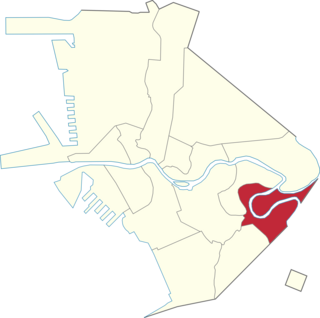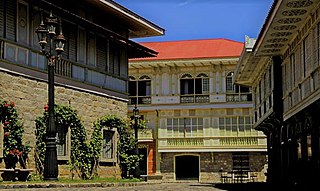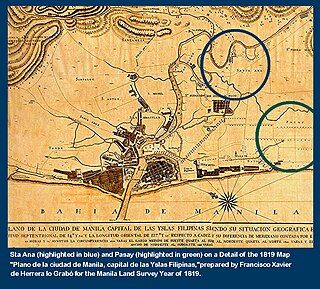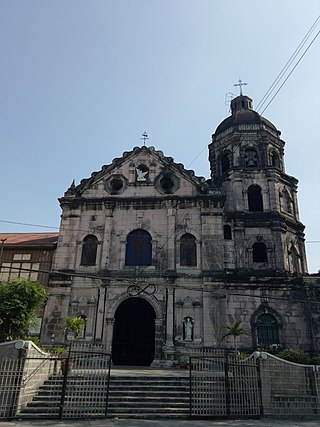
The Pasig River is a water body in the Philippines that connects Laguna de Bay to Manila Bay. Stretching for 25.2 kilometers (15.7 mi), it bisects the Philippine capital of Manila and its surrounding urban area into northern and southern halves. Its major tributaries are the Marikina River and San Juan River. The total drainage basin of the Pasig River, including the basin of Laguna de Bay, covers 4,678 square kilometers (1,806 sq mi).

Mandaluyong, officially the City of Mandaluyong, is a highly urbanized city in the National Capital Region of the Philippines. According to the 2020 census, it has a population of 425,758 people.

Intramuros is the 0.67-square-kilometer (0.26 sq mi) historic walled area within the city of Manila, the capital of the Philippines. It is administered by the Intramuros Administration with the help of the city government of Manila.

Quiapo is a district of the city of Manila, in the National Capital Region of the Philippines. Known as the “Old Downtown of Manila", the district’s most famous landmark is Quiapo Church, a minor basilica enshrining Asia's most sacred Black Nazarene image, which has been processed every January in the historic district, attracting millions of devotees from all over the country and region. The historic district is also dotted with numerous heritage sites, ranging from ancestral and heritage houses such as those in Hidalgo Street, museums, art galleries, libraries, historic places of worship such as churches and mosques, historic cinemas, as well as historic parks and streets, many of which have been run over by informal settlers and the construction of shanty houses, as well as buildings built by corporations. Many historic sites were destroyed by both the Japanese and American colonizers during World War II without compensation or aid for reconstruction, while some post-war sites were demolished by certain corporations. In recent years, various heritage organizations, experts, and lawmakers have pushed for the re-vitalization of Quiapo as a heritage zone, including the rebuilding of lost heritage structures, the revamping of modern structures to fit the historic district's original aesthetics, as well as the planting of trees and plants and the refurnishing of streets to make the district more safe, walkable, and climate-adaptive.

Santa Mesa is a district in Manila, Philippines. It is surrounded by the Pasig River on the southwestern side, and by the San Juan River on its southern and eastern side. Land borders include the districts of San Miguel to the west and Sampaloc to the north; and to the northeast is Quezon City.

Pandacan is a district in Manila, Philippines, which is known in recent history for its former Pandacan oil depot which supplies the majority of oil exports in the country.

Santa Ana is a district in the City of Manila, Philippines. It is located on the city's southeast, bordering the cities of Mandaluyong and Makati in the east, the city districts of Paco and Pandacan in the west, and Santa Mesa in the north. It is part of the 6th congressional district of Manila, with thirty-five barangays. Based on the 2020 national census, the Philippine Statistics Authority reports that the district has a population of 203,598.

The architecture of the Philippines reflects the historical and cultural traditions in the country. Most prominent historic structures in the archipelago are influenced by Austronesian and American architectures.

Namayan, also called Sapa, Maysapan, and sometimes Lamayan, was a Luzonian town that is now the Santa Ana district in Manila city proper along the Pasig River in the Philippines.

The San Juan River is one of the main river systems in Metro Manila, Philippines, and is a major tributary of the Pasig River. It begins near La Mesa Dam as the San Francisco del Monte River, which officially takes the name San Juan River when it meets with Mariblo Creek in Quezon City. As the San Juan River, it passes through Quezon City, San Juan, the Manila district of Santa Mesa and Santa Ana, and Mandaluyong.
The Pasig River Expressway (PAREX) is a proposed elevated expressway in Metro Manila, Philippines skirting the banks of the Pasig River and connecting the cities of Manila, Mandaluyong, Makati, Pasig, Taguig and the municipality of Taytay. The expressway is proposed to alleviate east-west traffic congestion in Metro Manila. It is envisioned as a joint venture between the Philippine National Construction Corporation and the San Miguel Corporation. The project broke ground on September 24, 2021, while construction of the expressway was yet to start, pending the approval of its Environmental Compliance Certificate (ECC). The project was deemed cancelled in 2024 due to public uproar against the project. However, Ramon Ang announced renewed interest in the project, albeit citing the need to adjust it toward public sentiment.

The National Shrine of Our Lady of the Abandoned, also known as Santa Ana Church, is a Spanish colonial period Roman Catholic church located in the district of Santa Ana in Manila, Philippines. It is under the jurisdiction of the Archdiocese of Manila. The parish was established by the Franciscan missionaries in 1578 under the patronage of Saint Anne. The present stone church was constructed by Vicente Inglés from 1720 to 1725 and was dedicated to its present patron, the Our Lady of the Abandoned. The revered image of its patron was made in Valencia, Spain in 1713 and arrived in the Philippines in 1717.

The Minor Basilica and Archdiocesan Shrine Parish of Saint Anne, commonly known as Santa Ana Church, is a Roman Catholic church and minor basilica located in Barangay Santa Ana, Taguig, Philippines. It is under the jurisdiction of the Diocese of Pasig. The church is situated next to the Taguig River and across Plaza Quezon, where the statue of Manuel L. Quezon was erected during his tenure as President of the Philippines. Saint Anne is the patroness of the church.

The Cobangbang Ancestral House is a heritage house in Manila, Philippines built in 1930 by Aurelio Cobangbang. It is located within the heritage zone of Santa Ana, the only district in Manila which was spared from destruction during World War II.
Santa Ana is the only district in Manila which was spared from destruction during World War II. Civilians fleeing other parts of Manila sought refuge in this district during the war. Thus, many ancestral houses are still standing up to the present time. Dubbed as the "Forbes Park of Manila", some houses were owned by prominent personalities and wealthy families. The following is a list of historic houses in Santa Ana.

The following outline is provided as an overview of and topical guide to Metro Manila:

The following is an alphabetical list of articles related to the Philippine capital region of Metro Manila.

Pasig Rainforest Park, also known as Pasig City Rainforest Adventure Experience and Pasig Central Park, is a public park in Pasig, eastern Metro Manila, Philippines. It spans 8 hectares, and is a mixed recreational and natural park with a mini-zoo. The rainforest park was opened to the public in 1977 with an initial area of 4.8 hectares. It had an Olympic-sized swimming pool, jogging oval, children's playground, tennis courts and a fitness center. In 1996, the park was enlarged with the acquisition of an additional 2.1 hectares. The park was relaunched as the Rainforest Adventure Experience (RAVE) in 2013 with the completion of the boating lagoon, zip line, obstacle course and a skatepark.

The Santa Ana Heritage Zone is a portion of the district of Santa Ana, Manila, Philippines, that was declared a heritage zone in 2014 by the National Historical Commission of the Philippines (NHCP). A larger portion of district was previously declared a histo-cultural heritage/overlay zone by the city government of Manila in 2011.

The Mira-Nila House is a historic mansion building in Quezon City, Metro Manila, Philippines. Situated along Mariposa Street in Cubao, the building owned by the Benitez family is a declared Heritage House by the National Historical Commission of the Philippines, and one of the only two such declared houses in Metro Manila along with the Lichauco Heritage House in Santa Ana, Manila. The building currently houses a museum.






















